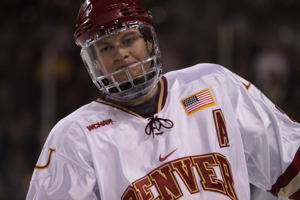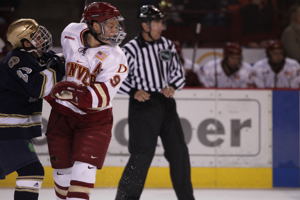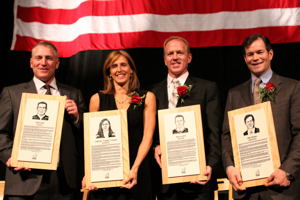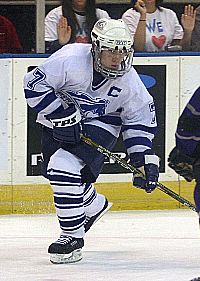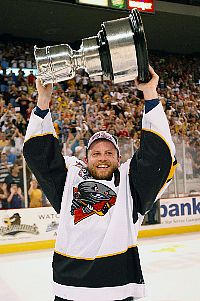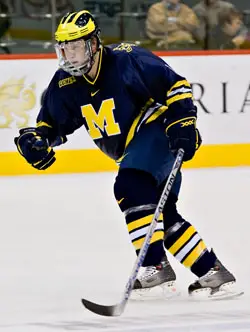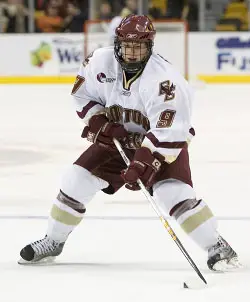Stability in the coaching ranks. For the first time in four years, all the coaches return.
However, that doesn’t mean there is going to be stability everywhere else. This is college sports, and changes are a matter of course. Players only stay around for four years, at the most, and coaches are constantly looking for that key recruit that will put them over the top.
The SUNYAC has seen changes over the past few years. Morrisville is playing in their third year as a conference member, and already the schedule has changed to accommodate them. In the past two years, some schools played the Mustangs two straight games at a single location. However, the league understood the unfairness of that sort of arrangement, so they worked out a way to play the team without a travel partner both home and away.
This means fans will have to get used to another change — the unevenness of the standings. No longer will every team have played the same number of conference games on any given date during the year. There will constantly be games in hand for some schools until the season is concluded.
After years of domination by a select few, there has been four different SUNYAC champions in the past six years (Plattsburgh and Geneseo twice each, Oswego, and Fredonia) with two different SUNYAC teams making it to the national title game the past two years. Oswego won it all in 2007 while Plattsburgh fell in the final game last season. The passing around of the SUNYAC trophy is testament to how tough and balanced the league has become.
“Our league is getting better and better,” Oswego coach Ed Gosek said. “All the coaches are working hard. It’s contagious. All the teams have raised their levels.”
“I have to believe that every single year, the conference has gotten stronger and stronger. And this year, it will probably be the strongest yet,” Fredonia coach Jeff Meredith said.
“No team is a pushover, easy win.” Potsdam coach Aaron Saul said.
“Everyone is good across the board,” Morrisville coach Brian Grady said. “It’s such a great league. It makes it fun. You can’t take a shift off, a night off. As a new program looking to build their program, it gives us something to look up to.”
And it gives the fans something to look forward to all season long. The coaches may have stayed the same this year, but new players, more parity, and a changed schedule will keep this season fresh.
There is also something new for Plattsburgh fans to get excited about: a newly renovated Stafford Arena.
“The rink looks great. Other than the walls and ceiling, it’s a brand new facility,” Plattsburgh coach Bob Emery said.
The renovated rink appears to be the equal of the new Campus Center at Oswego. Perhaps, this will lead to other new or renovated rinks which will continue to raise SUNYAC’s standing in the Division III hockey world.
In the meantime, it’s time to drop the puck for the 2008-09 season.
Plattsburgh State Cardinals
Coach: Bob Emery, 20th season overall and at Plattsburgh (422-138-42)
2007-08 overall record: 25-5-0
2007-08 SUNYAC record: 14-2-0
2007-08 SUNYAC finish: First
2008-09 Predicted finish: First
How do you top a season where you win your conference both in the regular season and the tournament and make it to the national championship game? Simple. Win that last game.
“We’ve been stressing all along, we’ve been very happy with our season, but there’s only one team who was satisfied,” Plattsburgh coach Bob Emery said. “We’re looking at ways to improve, so we can be that satisfied team at the end of the year.
“We’re looking for people to come in and fill some thankless jobs. We need some energy guys, some toughness that we lost last year.”
Some of those role playing seniors from last year include T.J. Cooper, Mike Baccaro, and C.J. Tozzo.
One area where the Cardinals do not have to worry about is goaltending. In fact, that was something they fixed last year, which got them as far as they did, after a few seasons of searching.
“No matter how good a team is, you have to have a good, consistent goaltender,” Emery said. “The game has changed so much, so that you have to have a solid goaltender to win. You have to offset the other team’s goaltender.”
Plattsburgh’s answer to that is Bryan Hince. As a freshman, he had a 2.02 GAA and .916 save percentage. Most importantly, unlike the recent past, Hince made the key saves when the team most needed them.
“Bryan Hince solidified our goaltending being a top goaltender at this level,” Emery said. “He has to now go out there and prove last year wasn’t a fluke.”
As for the rest of the team, Emery isn’t too worried about the other positions.
“I’m trying in Plattsburgh to be a balanced team,” he said. “We had no superstars last year outside of Nick Rolls. I don’t think we’re going to have any superstars this year. I’m looking forward to having a team that is balanced where any line can get the job done.”
Many of their key “non-superstars” do return, including their nine top scorers, five of whom had double digit goals. In that batch is Dylan Clarke who had 19 tallies in his freshman year and Joey Wilson who had 20 assists. Oh, and Nick Rolls is back as well.
If Hince proves he was no fluke, Emery finds the guys to do the thankless jobs, and a balanced team shares the contributions, Plattsburgh won’t just be celebrating a newly renovated Stafford Arena with another conference title. They will find themselves in Lake Placid again in March. And perhaps this time they will be a lot more satisfied.
Oswego State Great Lakers
Coach: Ed Gosek, sixth season overall and at Oswego (96-31-13)
2007-08 overall record: 13-2-1
2007-08 SUNYAC record: 18-6-2
2007-08 SUNYAC finish: Second
2008-09 Predicted finish: Second
“There are a lot of questions that need to be answered,” Oswego coach Ed Gosek said.
One key quandary centers around the Lakers need to replace All-American goaltender Ryan Scott, who led them to the national championship in 2007. Though inconsistent at times, Scott was still the mainstay for Oswego the past four years. He played in 90 games, graduating with a mark of 61-21-6, a 2.31 GAA, and .915 save percentage. He also set a school record with nine shutouts.
“We have Chris Hyk returning,” Gosek said. “He got to see some action last year. He’ll be a senior. He’ll be given a shot. Our freshman, Paul Beckwith, we have high expectations for him.”
Hyk has played in only 11 games during his three years, accumulating a 9-0-2 record, 2.08 GAA, and .907 save percentage.
Gosek added, “We learned a long time ago, you can have a great team, but if you don’t have the goaltending, you don’t get very far.”
Another item that, if missing, will prevent a team from getting very far in the rough and tumble sport of hockey is grit and determination. Oswego at times last year was missing this key ingredient, seemingly relying on their national championship trophy in the showcase to carry them.
“[Brendan] McLaughlin and [Ryan] Ellis, we’re expecting big things from. They need to play like seniors,” said Gosek, mentioning some of his key returning players. “[Peter] Magagna, our captain, is the spark plug. [Garren] Reisweber, [Matt] Whitehead, [Derrell] Levy. We need them all to play like experienced veterans, but at the same time play with an edge. We don’t want them to be complacent.”
Most of the Lakers’ firepower is back, including their top four scorers. Only two skaters graduated (Tony DiNunzio and C.J. Thompson) which means they still potentially have a national championship contender . . . on paper.
If they do get complacent, there are a number of excellent freshmen waiting in the wings. Oswego, as usual, had another strong recruiting year.
“Jared Anderson should be able to add some depth on defense,” Gosek said. “Erek Selleck, big power forward who looks good. Owen Kelly, transfer from the Air Force Academy, is a smart player with good speed.”
If Oswego can find the answer to their goaltending vacancy and get that grit and determination back — something Plattsburgh is always known for — then they once again can take that top spot back.
“We have high expectations,” Gosek said. “Our goals are always the same — to get home ice in our playoffs, and put ourselves in a position to get the automatic bid to the NCAA. We think we have enough seniors, senior experience, senior leadership. We’re excited about that. They would like to redeem themselves from last year for not making the NCAAs.”
An angry Oswego team with the talent they have may spell doom not just for fellow conference members, but for the rest of the country as well.
Potsdam State Bears
Coach: Aaron Saul, second season overall and at Potsdam (10-13-4)
2007-08 overall record: 10-13-4
2007-08 SUNYAC record: 6-7-3
2007-08 SUNYAC finish: Fourth
2008-09 Predicted finish: Third
New coaches always have two obstacles when they come into a program — they are taking over someone else’s team and have very little time to do their own recruiting.
“Just allowing us a year to recruit as opposed to a month is an improvement,” Potsdam coach Aaron Saul said. “[Assistant coach Darcy] Pettie and I spent a lot of time on the road to get the players we wanted. We feel we have a lot of impact players.”
In fact, some feel Potsdam may have one of the best recruiting classes.
“I’m really happy with the guys we have up front,” Saul said. “I think they can make an impact right away.”
They include Todd Hosmer, Adam Martinez, Sy Nutkevitch, and Anthony Proteau. On the blueline, everyone is talking about Hunter Sprydiuk, or rather the size of Sprydiuk. Without skates, he stands at 6-6 and 212 lbs. That should help a defense that includes returnees Steve Cornelissen and Jeff Zatorski, but lost Lance Smith and Vince Tarantino.
Up front, the top three scorers from last year return.
“Luke Beck, Connor Treacy, and Fraser Smith,” Saul said. “We’re looking for them to obviously carry us up front.”
Those three along with Peter Vaisanen, Kevin MacLellan, and Colin MacLennan combined with the promising freshmen should easily fill the gap left by the only senior forward from last year, Greg Lee.
Goaltending, of course, will be a key for the Bears. In fact, it will be goaltending that will most likely decide whether Potsdam finishes ahead of Fredonia or behind them like last year. The Bears started the season out letting up a ton of shots each game, but as they improved in that category, so did their record.
However, they were never able to truly settle on a number one backstopper. Rick Miller was supposed to be that guy, but a slow start opened the door for senior Rob Barnhardt. With Barnhardt gone, it’s Miller’s job to lose. And lose it he will if he starts out slow once again.
Freshman Trevor O’Neill will be more than ready to take the spot if need be.
“O’Neill had a pretty good showing [in training camp],” Saul said.
Potsdam improved steadily throughout the season as the team bought into Saul’s style. They surprised some very good teams, beating Plattsburgh and Manhattanville, both of whom made the NCAA playoffs. The Bears also wound up hosting and winning a first round SUNYAC playoff game.
With that success as their foundation and a full year of recruiting by Saul, Potsdam is poised to return to the conference’s elite.
Fredonia State Blue Devils
Coach: Jeff Meredith, 21st season overall and at Fredonia (296-208-50)
2007-08 overall record: 15-9-3
2007-08 SUNYAC record: 10-4-2
2007-08 SUNYAC finish: Third
2008-09 Predicted finish: Fourth
Fredonia proved that 2006-07 was not a fluke. Though the Blue Devils did not repeat as SUNYAC champs, they were always a team to be reckoned with. In fact, they had a better overall and conference record last year than the year before, finishing in third place.
Picking them lower than third is a dangerous proposition. Taking them lightly any time during the year will be even worse. Coach Jeff Meredith once again has a team that suits him.
“I got a group, and had groups like this, that worked so hard over the summer,” Meredith said. “Extremely self motivated. And I have some great leadership.”
Gone is their top scorer, Neal Sheehan, as well as defensive standout, Steve Albert. A number of returning forwards and freshmen are ready to pick up the slack.
“Up front, you’re looking at guys like Brian Goudy, Matt McKeown, Rick Boyce,” Meredith said. “Jordan Oye had a good freshman year. Pat Capella hasn’t put up big numbers, but he has gotten better every single year.”
As for newcomers, keep your eyes on Bryan Ross and Billy Sanborn. On defense, Colin Sarfeh, who was the team’s second leading scorer, returns for his senior year.
Despite Kevin Amborski not returning for his junior year, Meredith is not worried about the goaltending situation.
“I think our goaltending status is in as good as shape as it’s ever been,” Meredith said. “You look at Pat Street as our number one guy. If you look at his numbers [2.47 GAA, .927 % , even better in conference play] he had a great year, and we’re looking to build on that. Kody [Van Rentergem] has got a lot of potential. Young guy. Question is, how much and how soon will he get to play?”
So why not pick Fredonia for third? Because of their schedule. Their first six games are on the road and through January 10, only three games are home out of 15. At least those three are conference match ups.
“We’ve been unbalanced here from one year to the next,” Meredith said. “You deal with it, and it’s not a bad time of year to be on the road. Opening on the road is less pressure. You can play a little bit simpler.”
Perhaps, but it also eventually wears you down. If Fredonia can overcome that schedule and the senior leadership that has Meredith feeling so optimistic, then the Blue Devils will not only have a great shot at third, but could set their sites on perennial favorites Oswego and Plattsburgh.
Buffalo State Bengals
Coach: Nick Carriere, fourth season overall and at Buffalo State (33-38-7)
2007-08 overall record: 10-12-4
2007-08 SUNYAC record: 5-7-4
2007-08 SUNYAC finish: Sixth
2008-09 Predicted finish: Fifth
After a coach has been at the helm for a few years, that team begins to take on the style, attributes, and personality of that coach. So it is with Buffalo State under Nick Carriere, entering his fourth year at the largest college in the SUNYAC.
“Pretty different team than we’ve had in the past,” Carriere said of this year’s squad. “We finally have three recruiting years under us. It feels like our team. The juniors and seniors have stepped up in the leadership role. It feels kind of relaxing since the seniors have taken on a more active role.”
Some of those upperclassmen include last year’s leading scorer, Nick Petriello (12 goals, 18 assists, 30 points), Tyler Soehner, Joe Curry, Travis Whitehead, and D’Arcy Thomas. And let’s not forget Jason Hill.
“Jason Hill has been a go to guy the past couple of years,” Carriere said. “He’s had some injuries. He really made a commitment over the summer to be in the best shape possible.”
They will have to continue to step up to replace Nick Lynch, Jeff Mok, and Johnny Duco who all graduated last year.
Carriere is also excited about some of the new recruits coming in.
“Jim Durham is a local guy who played for the Junior Sabres,” he said. “He’s stepped right in and been all over the ice for us during practice. Impact freshman right from the start. Cory Park is a big guy [6-1, 215]. Big shooter.”
Also keep an eye on defensemen Sean Murray and Will Lacasse.
Goaltending is going to be a very interesting, and key, question mark for the Bengals. Neither Kyle Gunn-Taylor nor Travis Moore, both sophomores last year, returned. Instead, Johnathan Sourwine, who hasn’t played a minute, is back as a junior. No need to panic, however, as there are two new netminders coming in.
“Two of our goaltenders, Zach Grasley and Alan Fritch, are freshmen and will be competing for the number one spot,” Carriere said. “Still up in the air at this point.”
Buffalo State had a slightly off year last season after some wonderful growth the year before, hosting their first ever playoff game. Was last season merely part of the growing pains of a program that has been better off ever since Carriere arrived?
This is now Carriere’s team — his style, his attributes, his personality. If they respond, the Bengals will be back in the hunt for a home playoff spot. If not, they will be struggling just to get in.
Cortland State Red Dragons
Coach: Joe Baldarotta, 17th season overall (276-183-41) and second season at Cortland (11-12-3)
2007-08 overall record: 11-12-3
2007-08 SUNYAC record: 6-8-2
2007-08 SUNYAC finish: Fifth
2008-09 Predicted finish: Sixth
The most unpredictable prediction this year is where will Cortland end up? Joe Baldarotta came in last season to turn the program around. However, he did not have any time to recruit his own players. Nonetheless, Cortland did improve to nearly .500 and a playoff spot, just one point away from a home spot.
“We finished in fifth place just one point behind Potsdam,” Baldarotta said. “That one point came in a tie at Potsdam when we played well in overtime but couldn’t get the winning goal. That one point was a loss to Plattsburgh on a goal with 45 seconds left. It wasn’t one point, it was one goal. Last year, we didn’t have the guys to get that one goal or not let up that one goal. This year we do.
“In fairness to the guys who were here, we took some strides. Now, we are aiming for the top three to four spots.”
“Try to make a big changeover,” Baldarotta said. “We lost through graduation and other means 17 guys. I brought in about 16.”
The team’s top three scorers from last season — Jarrett Gold (13-11-24), Frank Rizzo (11-10-21), and Gerard Heinz (4-16-20) — are returning, as is Patrick Palmisano and Nick Catanzaro. The new players, though, are currently a question mark.
“We won’t have superstars like other teams do,” Baldarotta concedes. “Hopefully, in the future we will be able to get guys like that. But right now, we have to do it by committee. This year I have to rely on everybody to pitch in.”
Goaltending, of course, will be a key. As expected, the Ben Binga saga didn’t play well with Baldarotta. Jon Bova has graduated. Mike Mistretta, who played the bulk of the minutes, is back for his senior year.
“We didn’t lose any games last year because of our goaltending, but now we can flat out win one with our goaltending,” Baldarotta said. “Couple of new goaltenders. Dan Jewell, transfer from Manhattanville, was supposed to play last year, but was injured. Mike Reilly is a freshman out of junior hockey.”
So, just where do you pick Cortland? Is the big changeover going to cause a slow start? Will Baldarotta’s experience and prior success translate to a complete turnaround for the Red Dragons? Baldarotta’s philosophical about it.
“I think the first thing everyone wants is to compare you to last year,” he said. “I think it’s unfair to compare this team to how we were at the end of the year. I want to compare us to how we were in October. I’m trying to get guys into a spot where they are competitive by the end of the season.”
One thing is for sure. Baldarotta may be shooting for the top three to four spots, but he is determined not to settle for mediocrity.
“Why stop there? Shoot for the top spot,” he said. “I’ve never been a guy who was satisfied with sixth place.”
With that attitude, predicting where Cortland will finish is done at your own risk.
Geneseo State Ice Knights
Coach: Chris Schultz, third season overall and at Geneseo (24-27-0)
2007-08 overall record: 8-17-0
2007-08 SUNYAC record: 6-10-0
2007-08 SUNYAC finish: Seventh
2008-09 Predicted finish: Seventh
Three consecutive years of coaching changes finally caught up to Geneseo last season. Despite Chris Schultz returning to his alma mater for a second year, the effects on recruiting could not be offset. This led to a disappointing season as the Ice Knights went from two-time SUNYAC champions to failing to make the playoffs in just two years.
“The recruiting went well,” Schultz said. “So far we’re happy with their performance in practice. But you can never tell how they will actually perform in a game just from practice.”
Returning for his third season behind the bench should add stability to the program, starting with recruiting. Geneseo is going to need it, because some key players graduated last year. Gone are their top two scorers (Mathieu Cyr and Trent Cassan), key defenseman Steve Sankay, and their number one goalie who played in 23 games, Derek Jokic.
Returning are double digit goal scorers Dan Brown and Kevin Galan. So is Daniel Sullivan and defensemen Casey Smith and Chris Kestell.
The makeup of this team is going to be different than those championship squads which possessed players with great skill.
“Our attitude this year, it’s going to be a committee,” Schultz said. “We’re expecting everybody to chip in and contribute. There are no superstars on the team that we can count on to do all the work for you.
“The team is a year older as compared to last year. I think we have four lines that can play, good speed, good skill, and strong defense. The goaltending will be a question mark. We need the goaltending to step up and play a big role.”
A big question mark indeed. Without Jokic, who was able to step right into Brett Walker’s skates, Geneseo once again needs to fill an all important position.
Jeff Pasemko, who played in seven games last year, is back for his senior season. Coming in as a freshman is Cory Gershon. Christian Berlin is a transfer from junior college, Minot State-Bottineau.
“We have confidence, but we want to see if one steps up to be the number one guy or if we alternate,” Schultz said.
Despite the stumbles of last year and the issues with the coach’s revolving door catching up to the Ice Knights, the team knows darn well the reputation they built up, and have no intentions of letting it slip away.
“We’re expecting a SUNYAC championship,” Schultz says with confidence. “There’s a lot learned from last year that has the guys wanting to make up for it.”
How well they learn will determine if their expectations are met, or if they are outside looking in for the playoffs once again.
Brockport State Golden Eagles
Coach: Brian Dickinson, 14th season overall (82-215-32) and 11th season at Brockport (68-167-26)
2007-08 overall record: 7-15-3
2007-08 SUNYAC record: 4-10-2
2007-08 SUNYAC finish: Eighth
2008-09 Predicted finish: Eighth
The great four year experiment is over. The class that Brian Dickinson brought in for a fresh start in a complete overhaul has graduated. In their junior year, Brockport made the playoffs. However, last season was a step back as they finished eighth and were the first SUNYAC victims to upstart program, Morrisville.
Despite that class graduating, Dickinson doesn’t have to start from scratch again. Over the years, through attrition and new recruits, the number of players who left was not as large. Nonetheless, new players it is.
“The word for us this season is ‘green’ because of the number of new players we’ve had to bring in, getting used to the new system, getting them ready for the speed at this level,” Dickinson said. “Hopefully, we’ll get off to a quick start, so that we can start feeling good about ourselves.”
Gone are their top three scorers (Chris Koras, Gordon Pritchard, and Steve Seedhouse) and their top offensive defenseman (Chris Brown) as well as their occasional number one goalie, Greg Van’t Hof.
The team’s fourth scorer, Tim Crowley, perhaps their most improved player last year, is back.
“Tim Crowley started as a fourth liner as an energy guy, but worked his way up to the top line,” Dickinson said. “Last January, he was probably our best guy on the ice.”
Other players will also need to step up.
“We need Dave McNab up front to really fill a scoring need for us. He has the ability to create and put the puck away,” Dickinson added. “Sean O’Malley is also going to be someone we are going to rely on.”
Mike Gershon will be the leader on defense, but the key returning player is goaltender Todd Sheridan, who at times has been the cream of the crop in the SUNYAC.
“[Todd] Sheridan has to be the rock he has been for us the past two years,” Dickinson said. “He has looked excellent in practice and there is no sign of any of the groin injuries that plagued him in the past.”
One interesting addition is junior transfer Jason Gorrie from Plattsburgh.
“He had a really good freshman year for them, but then got injured,” Dickinson explained. “With all the success they had last year, there was no longer any room for him.
“Whole bunch of other guys who we think are going to be good, but it just takes some time for them to adjust to this level of play.”
One thing is for sure, if Brockport is going to make the playoffs again, they have to avoid playing catch up in the second semester. Their conference schedule favors the Golden Knights as they play just one SUNYAC game each of the first two league weekends.
“When you’re fighting for points in the second semester just to stay in the hunt, that takes its toll. It is key for us to get points early,” Dickinson said.
Morrisville State Mustangs
Coach: Brian Grady, second season overall and at Morrisville (5-20-0)
2007-08 overall record: 5-20-0
2007-08 SUNYAC record: 1-15-0
2007-08 SUNYAC finish: Ninth
2008-09 Predicted finish: Ninth
The Mustangs enter their second season as full fledged members of the SUNYAC. Last year, they claimed their first conference win, a 3-1 victory over Brockport in the next to last contest. This year, they plan on improving on that.
“We’re better at every position than last year,” Morrisville coach Brian Grady said. “We have more skill. We have more depth. I’m really excited about the shape the guys are in. They really worked hard over the summer.”
Gone is Matt Damskov, their second leading scorer last season, but returning is their top scorer, Rob Sgarbossa (12-10-22).
“Had a great season for us last year,” Morrisville coach Brian Grady said of Sgarbossa. “Definitely our best player. Can get it done anywhere. Takes pride in the defensive zone. Does it all for us.”
Also returning is Brent Quinn, who has a point to prove.
“He missed half a year last year for team discipline action,” Grady said. “He’s got great skill. Really applied himself over the summer. The sky is the limit for him.”
On defense, the Mustangs’ top blueliner, Evan Kernohan, is back for his junior year.
“Has a good eye for the game,” Grady said. “Anticipates well. He was a forward converted to defense, so he knows how to jump into the offense.”
Look for freshman Tom Longland to be another Kernohan, according to Grady, “We’re excited about him. Same mold as Evan. Fluid skater. Competitor. Will bring a lot to us both on the ice and off the ice.”
Of course, for Morrisville to move up in the league and perhaps even battle for a playoff spot, it will come down to goaltending. And they just may just have the player for that in Caylin Relkoff. As a freshman, his numbers may not have been outstanding, but he faced a lot of shots behind a suspect defense.
“[Relkoff’s] back after a great freshman campaign,” Grady said. “Played the bulk of our minutes. Kept us in games we probably shouldn’t have been in. Won most of our games for us. He’s a big, solid, athletic kid.”
The schedule has been evened out for Morrisville this year, as they will now play every conference foe home and away, which will also avoid ending their season in January like last year.
It’s tough to be the new kid on the block, but Morrisville has gained a level of respectability, through hard work and constant improvement. To take them lightly is to do so at your own risk.
“I think we’re going to be a tough team to compete against. We’re going to work hard for 60 minutes. That will be our trademark,” Grady said.
